In our most recent Short Story, we looked at the friendship between the Hewitt and Carnegie families, and how those relationships still shape Cooper Hewitt today. This month, a research mystery catches our eye.
Recently, curatorial researcher Josephine Rodgers brought our attention to a lovely portrait of a woman given to the museum in 1931 by the Hewitt sisters. Was she a member of the Hewitt family? Why would this be bequest by the sisters to the museum? Rodgers identified this sketch as the work of well-known artist James Carroll Beckwith (1852–1917). What was his relationship to the Hewitts? And who is this mystery woman? Researchers love a good mystery!
Margery Masinter, Trustee, Cooper Hewitt, Smithsonian Design Museum
Sue Shutte, Historian at Ringwood Manor
Matthew Kennedy, Publishing Associate, Cooper Hewitt, Smithsonian Design Museum

Portrait, ca. 1890; J. Carroll Beckwith; Pastel crayon on paper; Gift of Sarah Cooper Hewitt and Eleanor Garnier Hewitt, 1931-36-23; Cooper Hewitt, Smithsonian Design Museum
Le Meilleur Peintre de Pastel
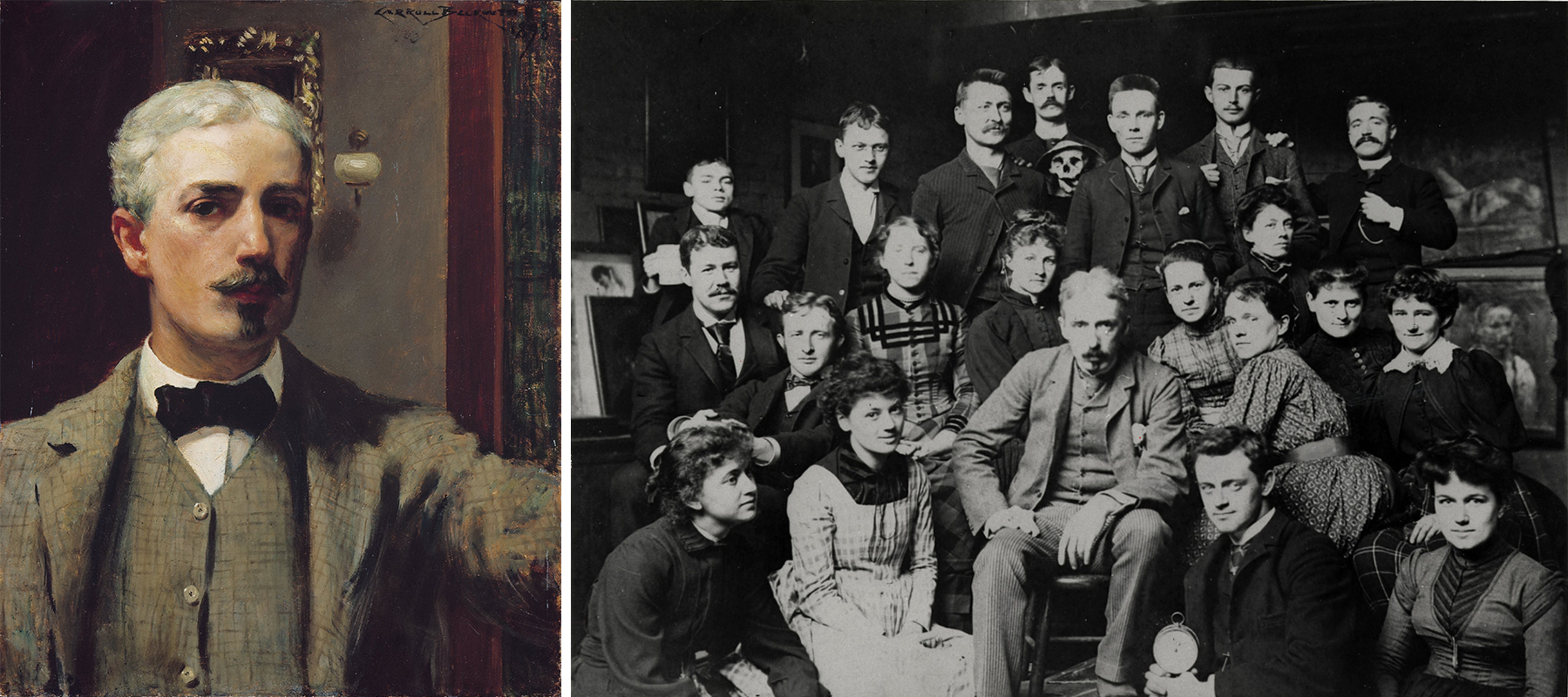
(left) J. Carroll Beckwith. (right) J. Carroll Beckwith (center) with his class, ca. 1895 / unidentified photographer. Art Students League records, 1875–1955. Archives of American Art, Smithsonian Institution.
Carroll Beckwith—as he preferred, without “James” or “J.”—moved to New York from Missouri in 1871 to pursue a career as a painter. He was introduced within elite New York social circles by his great-uncle John H. Sherwood, the prominent banker and real estate speculator. After subsequently completing a pilgrimage to the finest art collections of Europe and studying with Charles Emile Carolus-Duran in Paris, the young artist returned to New York in 1878. Before the turn of the century, Beckwith achieved great success as a teacher and portraitist, along with the reputation as the doyen of American artists in New York that trained abroad.[1] In 1878, he also began to teach drawing at the Art Students League and later proclaimed, “In portrait painting, the preliminary drawing is the first and most important step in the creation of the work. This is especially true for a beginner, who should spend at least three or four hours drawing attentively.”[2] For Beckwith, the practice of drawing was paramount for “training of the hand and eye.” He brought this same philosophy to Cooper Union in 1884 by teaching a Life and Cast Drawing course. As a member of the Committee on Art for the Cooper Union Museum for the Arts of Decoration, he advocated for building a collection of drawings within the institution. As a committee member, advisor, and donor to the museum, Beckwith was devoted to promoting the institutional mission of the museum, set forth by the Hewitt sisters, to become “an educator of public taste.”
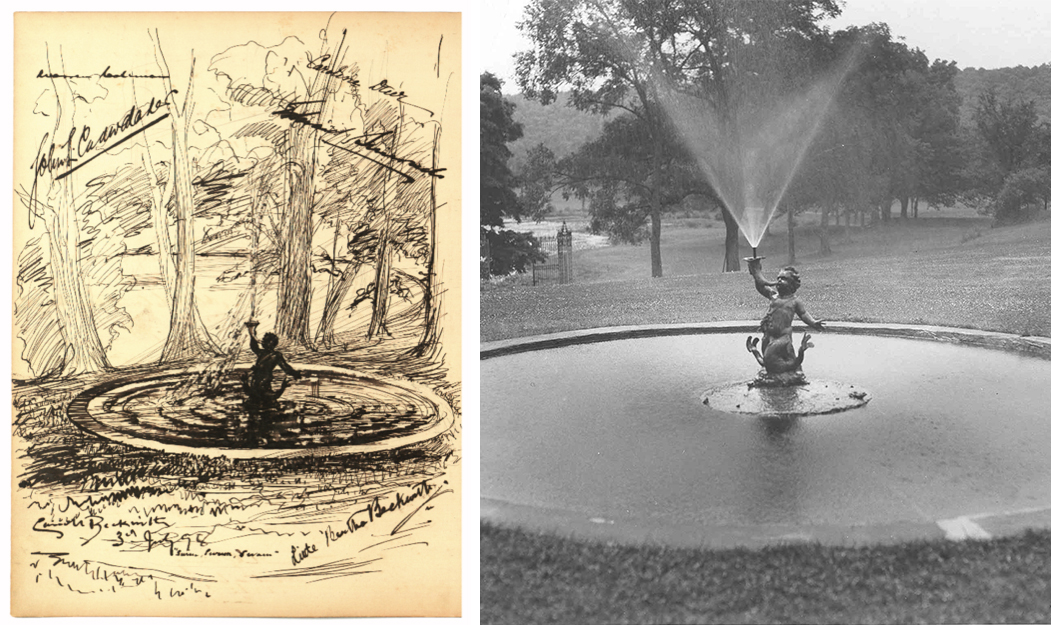
(left) Page from Ringwood guestbook illustrated by J. Carroll Beckwith and signed by other visitors, July 3, 1898. (right) Photograph of the Versailles Fountain at Ringwood Manor, Ringwood, New Jersey.
It is not apparent when exactly the Hewitt sisters were introduced to Carroll Beckwith, but on July 3, 1898, both Carroll and his wife Bertha visited Ringwood Manor, the Hewitt family country estate. Ringwood played host to an array of distinguished guests, including artists, authors, inventors, statesmen, and even royalty. The Ringwood guest books are treasured documents filled not only with autographs, but witty messages and cartoons, artwork and poetry. To commemorate the Beckwiths’ visit, Carroll drew a sketch of the Versailles fountain (located on the grounds of Ringwood just off the sun porch of the manor) in the guest book. The fountain remains a symbol of the Hewitt sisters’ esteem for French history and design—a passion that the artist also shared.
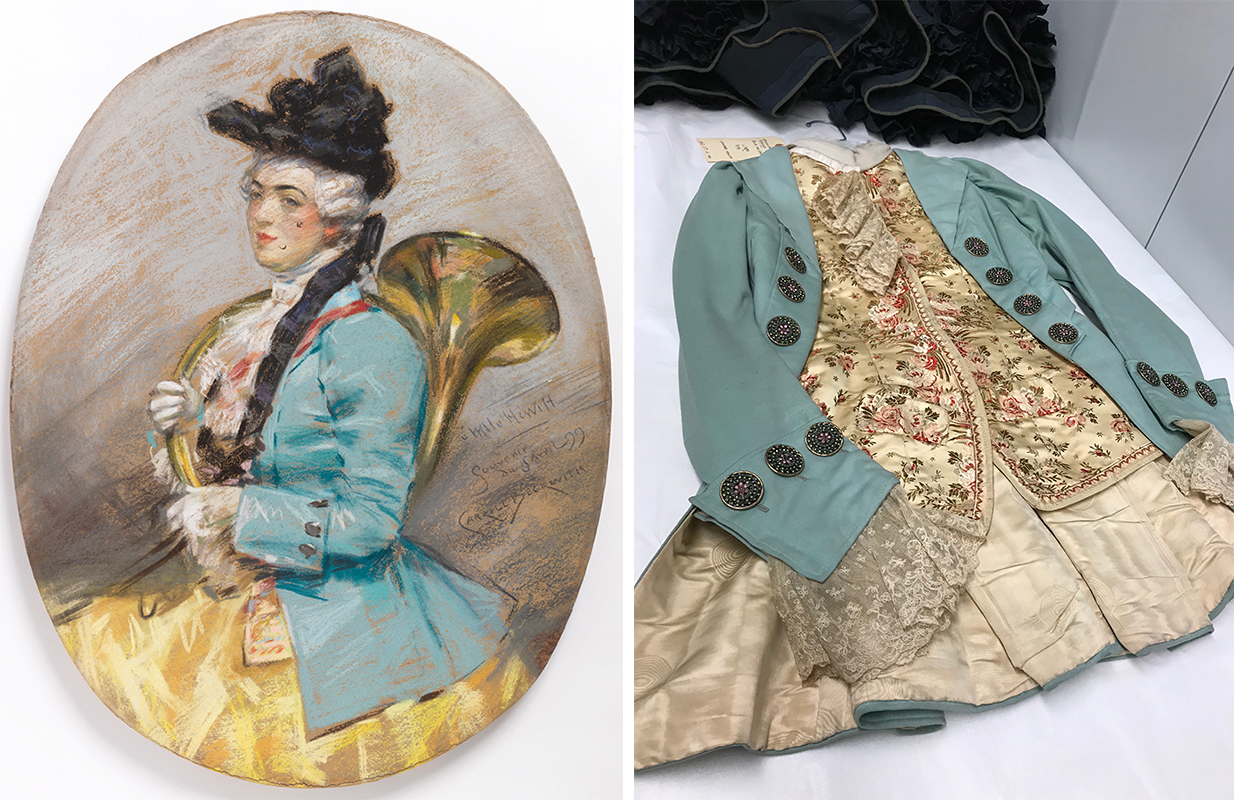
(left) Portrait of Sarah Cooper Hewitt, 1899; J. Carroll Beckwith; Pastel crayon on paper mounted on linen; Bequest of Erskine Hewitt, 1938-57-890; Cooper Hewitt, Smithsonian Design Museum; (right) French Riding coat from the collection of Sarah Cooper Hewitt, Museum of the City of New York
In 1899, Sarah Cooper Hewitt sat for a portrait by Carroll Beckwith, and the finished composition, Portrait of Sarah Cooper Hewitt (above left), captures the allure and beauty both sitter and artist admired of eighteenth-century French culture. Dressed in a wig, Sarah chose to wear her treasured Louis XVI-style riding jacket while holding a coaching horn. The Hewitt sisters frequented the exclusive fashion houses of Paris and took pride in wearing and collecting the latest fashion trends in New York. Today the riding jacket (on the right) is part of the collection of the Museum of the City of New York and is attributed to the House of Worth, Paris. Beckwith chose to complete the portrait in pastel. He signed the work on the lower right, “à Mlle Hewitt / Souvenir / du 5 Avril 99 / Carroll Beckwith.”
The pastel medium reached its greatest heights during the eighteenth century, and portraits became popular souvenirs for travelers on the Grand Tour. While studying in Paris, Beckwith was inspired by eighteenth-century painting and pastel portraits by Maurice-Quentin de La Tour (1704–1788). (The oval shape of Sarah’s portrait is a reference to de La Tour’s masterpieces.) Breaking from the French tradition of layering the pastel crayon, Beckwith followed a radical approach by leaving the individual markings exposed. Drawings, such as Portrait of Sarah Cooper Hewitt, evoke an almost jewel-like quality of light. Beckwith’s use of brilliant cyan highlights on her jacket offers a tour de force of his control and handling of color. The reddish-orange tint frolics across the surface of the paper, creating a sumptuous effect. The buttery surface of the drawing is something to marvel—the perfect rendition of light, the blaze of blue and gold drawn with such confidence. We know that the Hewitt family appreciated the craftsmanship and artistry of such work, and it possibly hung in one of the many rooms of their 9 Lexington Avenue home until the property was sold, finally entering the Cooper Union Museum for the Arts of Decoration collection as part of the Hewitt sisters’ estate.
Bertha and Carroll Beckwith’s signatures appear again in the Ringwood guest book on October 22, 1899, but unfortunately the event did not inspire an additional illustration. However, an additional drawing by Beckwith resides at Ringwood Manor, currently on display in Sarah’s bedroom. Little is known about this drawing—another mystery!
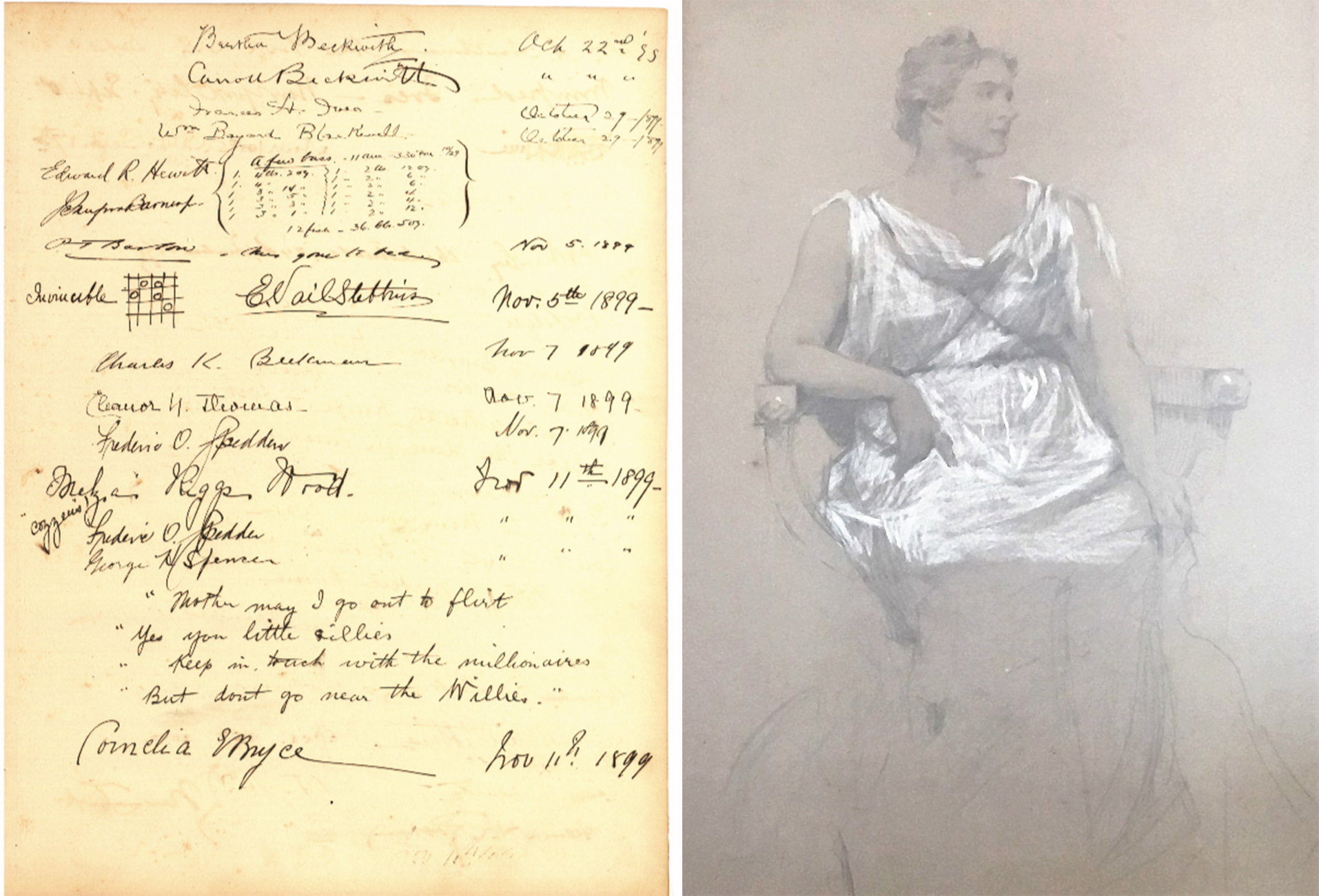
(left) Page from Ringwood guestbook sign by J. Carroll and Bertha Beckwith, October 22, 1899. (right) Drawing by Carroll Beckwith, ca. 1895, in the collection of Ringwood Manor.
In 1882, Beckwith became a founding member of the Society of Painters in Pastel with Robert F. Blum and William Merritt Chase. The Society’s first exhibition opened on March 15, 1884, at the W.P. Moore Gallery with 64 pastel drawings on display by seven members and seven guest contributors. Even though Beckwith did not sell any works at the inaugural exhibition, he continued to exhibit with the Society in May 1888 at Wunderlich & Company, in April 1899 at the Haseltine Gallery, and at the final exhibition in May 1890 at Wunderlich & Company.[3] Beckwith was one of the only artists to exhibit at all four Society exhibitions and was praised by art critic Walter Montgomery as among the best Americans working in pastel.[4] Today, without clear records, it is impossible to identify the drawings that Beckwith exhibited with the Society of Painters in Pastel.
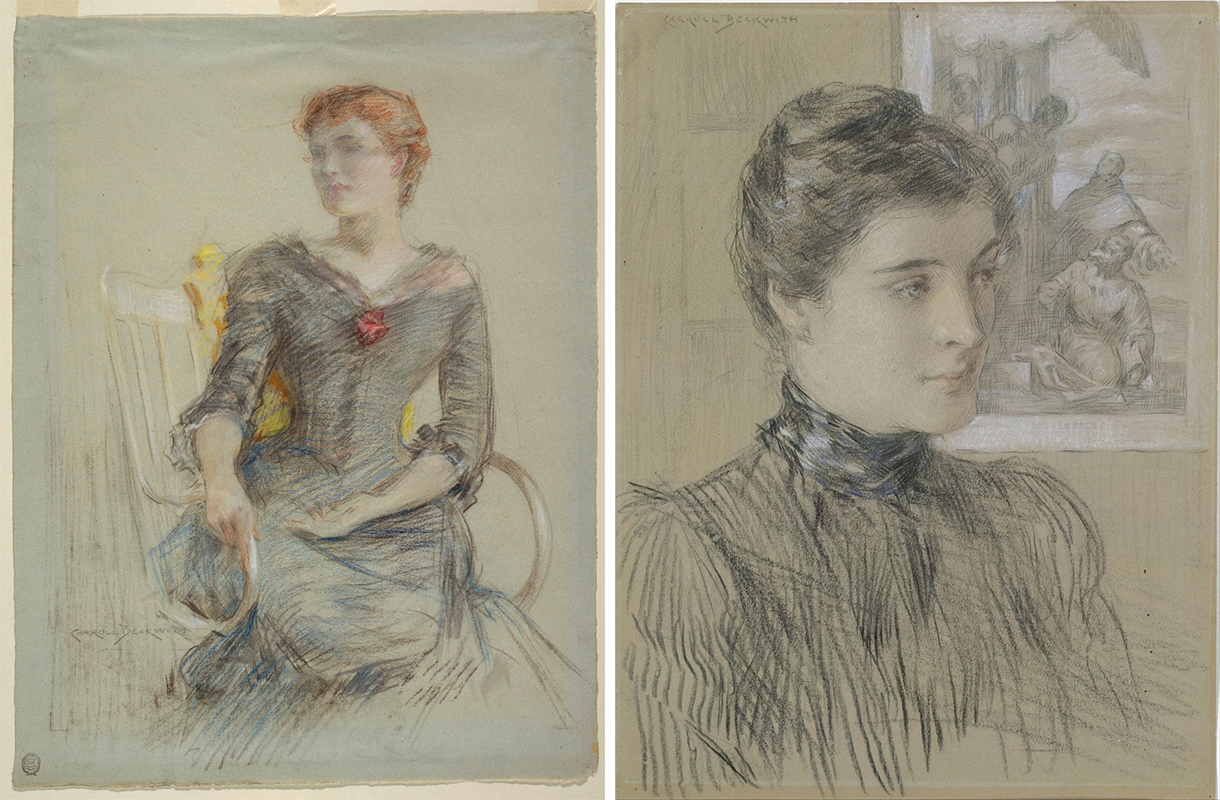
(right) Portrait, ca. 1890; J. Carroll Beckwith; Pastel crayon on paper; Gift of Sarah Cooper Hewitt and Eleanor Garnier Hewitt, 1931-36-23; Cooper Hewitt, Smithsonian Design Museum; (right) The Veronese Print, ca. 1890; James Carroll Beckwith; Black chalk and pastel on grey wove paper; Metropolitan Museum of Art, Gift of Janos Scholz, 1949
Cooper Hewitt’s pastel drawing at the heart of our mystery, identified as Portrait (above left), was acquired by the Cooper Union Museum for the Arts of Decoration in 1931 from the Hewitt sisters’ estate with no documentation. In 1937 it was catalogued without an attribution, title, or date. The drawing technique and coloring is exquisite. Carroll Beckwith’s signature in the lower left corner suggests the drawing was prepared for exhibition. William DeGregorio, PhD candidate, Bard Graduate Center, and Conservation Technician, Museum of the City of New York, suggests the style of dress would have been in high fashion between 1885 and 1890, further noting, “The sheer (probably chiffon or mousseline de soie) overlay over the bust, and possibly the sleeves, seems like a manner of mitigating a dinner dress that has been pulled down off the shoulders for the portrait.” He also commented that the sitter is seated in a manner to suggest the dress did not have an extreme bustle that was out of fashion by 1890.
Even with the help of these possible clues from dating the work, the identity of the figure remains unknown. The bright red hair and soft features does not resemble a Cooper or Hewitt family member, but could suggest the sitter is the artist’s wife Bertha. After marrying in 1887 Beckwith painted Bertha on numerous occasions. Pastel portraits, similar to The Veronese Print, ca. 1890 (above right, now at the Metropolitan Museum of Art, 49.167), were popular at the time and established Beckwith’s career as a painter. Could the Hewitt sisters have seen this portrait and were compelled to commission Beckwith to portray Sarah?
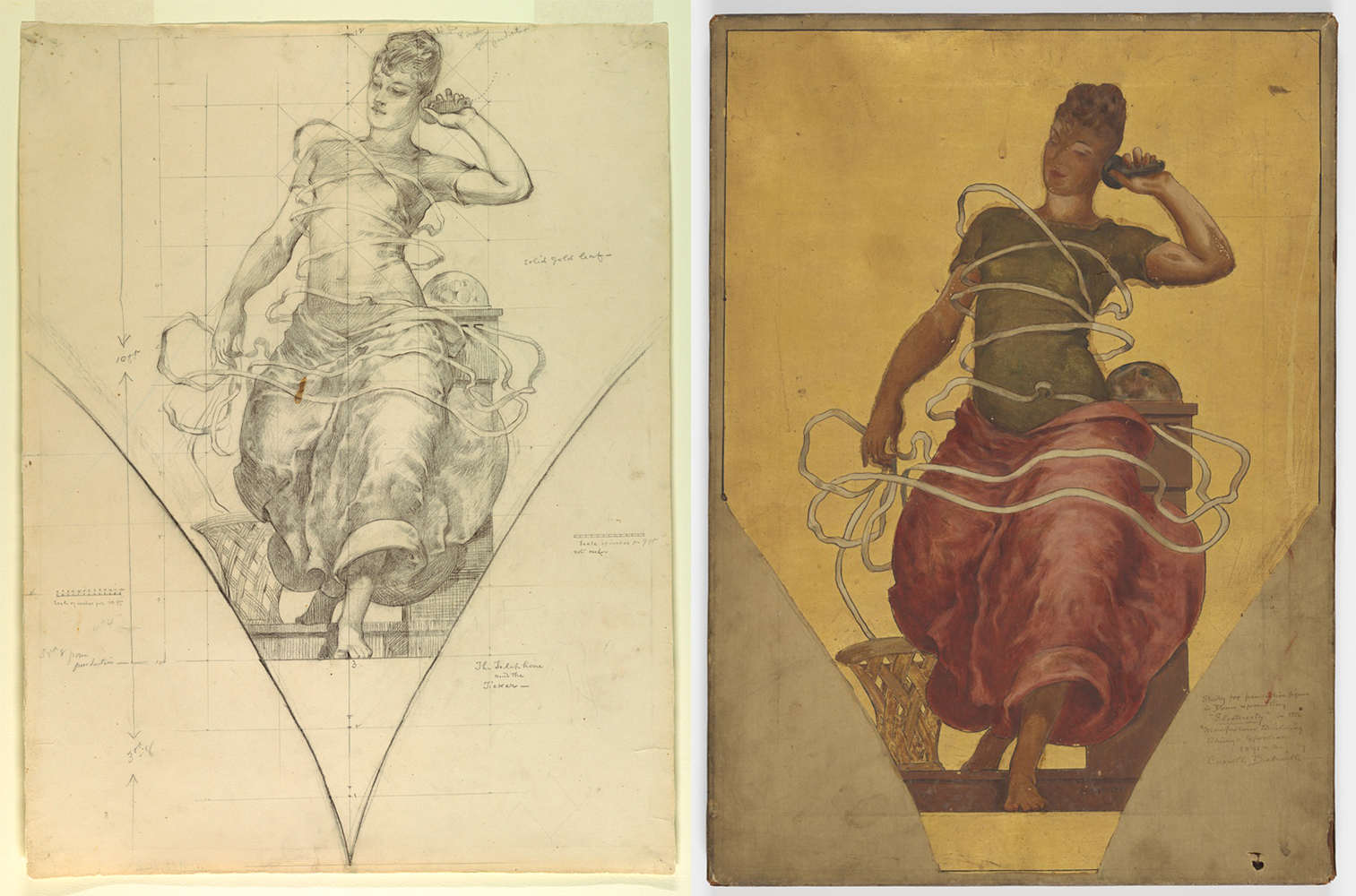
(left) Drawing, Study for Electricity as Applied to Commerce, Manufacturers and Liberal Arts Building, World’s Columbian Exposition, Chicago, Illinois, USA, 1892; J. Carroll Beckwith (American, 1852–1917); Black chalk, graphite on off-white paper; 62.4 x 47.2 cm (24 9/16 x 18 9/16 in.); Gift of J. Carroll Beckwith, 1915-2-6. (right) Painting, Study for The Telephone and the Ticker, Manufactures Building, 1891–92; J. Carroll Beckwith (American, 1852–1917); Oil on canvas; 54.7 x 39.5 cm (21 9/16 x 15 9/16 in.); Gift of J. Carroll Beckwith, 1915-2-7.
Correspondence between Beckwith and the “Misses Hewitts,” held within the registrar department at Cooper Hewitt, Smithsonian Design Museum reveals further invitations and demonstrates a compassionate friendship. A letter from February 28, 1914, references an intimate exchange of ideas concerning future collecting goals for the Cooper Union Museum for the Arts of Decoration. Beckwith makes the argument that it would be beneficial for students to copy paintings he made in Europe after the Old Masters to build drawing skills. However, by 1915 Beckwith decided that instead of donating the paintings he completed as a student, he would offer eight preparatory studies for the Electricity as Applied Commerce mural within the Manufactures Building at the Chicago World’s Columbian Exposition in 1893. With the addition of drawings from the Hewitt sisters’ personal collection, the Cooper Union Museum for the Arts of Decoration—and today Cooper Hewitt, Smithsonian Design Museum—preserves Carroll Beckwith’s legacy as an accomplished draughtsman, as the le meilleur peintre de pastel.
Dr. Josephine Rodgers is the former Research Assistant for American Art in the Drawings, Prints & Graphic Design Department at Cooper Hewitt, Smithsonian Design Museum.
Footnotes
[1] John Davis, “Our United Happy Family: Artists in the Sherwood Studio Building, 1880–1890,” Archives of American Art Journal 36, no. 3/4: 4.
[2] Pepo Marchetti Franchi and Bruce Weber, Intimate Revelations: The Art of Carroll Beckwith 1852–1917 (New York: Berry-Hill Galleries, Inc, 2000), 22.
[3] Dianne H. Pilgrim, “The Revival of Pastels in Nineteenth-Century America: The Society of Painters in Pastel,” The American Art Journal 10, no. 2 (Nov 1978): 43–62.
[4] Franchi and Weber, 24.

One thought on “Cooper Hewitt Short Stories: Carroll Beckwith and the Hewitt Sisters”
Cj Lisa on October 11, 2018 at 7:35 pm
Interesting history of the painter, pastels and representative art.